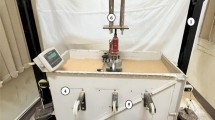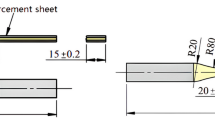Abstract
The cracking performance of semi-flexible pavement (SFP) was investigated by using the semi-circular bending (SCB) test in this paper. Thirteen grouting slurries were prepared. The compressive strength of these materials ranges from 3 to 100 MPa. The relationship between the compressive strength of the grouting slurry and the cracking property of SFP was obtained at different loading rates and different temperatures. The peak load, fracture energy (E), flexible index (FI), and cracking resistance index (CRI) were calculated to determine the material performance. The results show that the compressive strength of the grout influences the cracking behavior. With a higher comprehensive strength grouting slurry, the FI value of SFP decreased initially and then increased slightly at 25 °C in 50 mm/min. The CRI value decreased at the same time. E values changed just according to the test temperature and loading rate. The damage paths of SFP are different. The damage path of the SFP sample appears as diffuse damage at 1 mm/min at 60 °C or clean damage at 50 mm/min at 25 °C. These findings indicate that there is a correlation between the compressive strength of grouting slurry and SFP cracking behavior. The cracking form is influenced by loading rate and temperature.
Similar content being viewed by others
References
Jean Mayer, Mikael Thau. Jointless Pavements for Heavy-Duty Airport Application: The Semi-Flexible Approach[C]. Adv. Airfield Pavements, 2001: 87–100
Yang G L, Wu K H. Parent Asphalt Mixture Design of Semi-Flexible Pavement Based on Method of Main Mineral Aggregate Void Filling[J]. Adv. Mater. Res, 2012, 446–449: 2 599–2 602
I L Al-Qadi, H Gouru, R E Weyers. Asphalt Portland Cement Concrete Composite: Laboratory Evaluation[J]. J. Transp. Eng., 1994, 120(1): 94–108
A Setyawau. Development of Semi-Flexible Heavy-duty Pavements[D]. Leeds: University of Leeds, 2006
Hou S G, Tao X. Investigation into Engineering Properties and Strength Mechanism of Grouted Macadam Composite Materials[J]. Int. J. Pavement Eng., 2016, 17(10): 878–886
M L Afonso, M Dinis Almeida. Development of a Semi-Flexible Heavy Duty Pavement Surfacing Incorporating Recycled and Waste Aggregates — Preliminary Study[J]. Construction and Building Materials, 2016, 102: 155–161
M De Beer, J W Maina. Mechanistic Modelling of Weak Interlayers in Flexible and Semi-Flexible Road Pavements: Part 2: Technical Paper[J]. J. S. Afr. Inst. Civil Eng., 2012, 54(1): 43–54
S Koting, M R Karim. Mechanical Properties of Cement-Bitumen Composites for Semi-Flexible Pavement Surfacing[J]. Baltic J. Road Bridge Eng., 2014, 9(3): 191–199
J R M Oliveira, J C Pais. A Study of the Fatigue Properties of Grouted Macadams[J]. Int. J. Pavements, 2007, 6(1): 112–113
N Kawamura, Y Morikawa. Durability of High-Stability Asphalt Mixture Under Aircraft Loading[C]. FAA Worldwide Airport Technology Transfer Conference, 2014
K E Hassan, A Setyawan. Effect of Cementitious Grouting Slurry on the Properties of Semi-Flexible Bituminous Pavement[J]. Proceedings of the 4th European Symposium on Performance of Bituminous and Hydraulic Materials in Pavement, 2002: 113–120
Saha G, Biligiri K P. Homothetic Behavior Investigation on Fracture Toughness of Asphalt Mixtures Using Semicircular Bending Test[J]. Construction and Building Materials, 2016, 114: 423–433
Ding Q J, Zhao M Y. Mechanical Behavior and Failure Mechanism of Recycled Semi-Flexible Pavement Material[J]. J. Wuhan University of Technology-Mater. Sci. Ed., 2015, 5: 981–988
Saboo N, Khalpada V. Optimal Proportioning of Grout Constituents Using Mathematical Programming for Semi Flexible Pavement[J]. International Journal of Pavement Research and Technology, 2019, 12(3): 297–306
Fang B W, Xu T. Laboratory Study on Cement Slurry Formulation and Its Strength Mechanism for Semi-Flexible Pavement[J]. Journal of Testing and Evaluation: A Multidisciplinary Forum for Applied Sciences and Engineering, 2016, 44(2): 907–913
Tran T N, Nguyen H T. Semi-Flexible Material: The Sustainable Alternative for the Use of Conventional Road Materials in Heavy-Duty Pavement[C]. Congrès International De Géo technique — Ouvrages — Structures, Springer, Singapore, 2017
Yang B H, Weng X Z. The Influence on the Durability of Semi-Flexible Airport Pavement Materials to Cyclic Wheel Load Test[J]. Construction and Building Materials, 2015, 98: 171–175
Zhang J P, Cai J. Formulation and Performance Comparison of Grouting Slurry Materials for Semi-Flexible Pavement[J]. Construction and Building Materials, 2016, 115: 582–592
Suhana K, Rehan K M. Effects of Using Silica Fume and Polycarboxylate-type Superplasticizer on Physical Properties of Cementitious Grout Mixtures for Semi-Flexible Pavement Surfacing[J]. The Scientific World Journal, 2014: 1–7
A Setyawan. Design and Properties of Hot Mixture Porous Asphalt for Semi-Flexible Pavement Applications[J]. Media Teknik Sipil, 2005, 6: 41–46
Gong M H, Xiong Z J. Evaluation on the Cracking Resistance of Semi-Flexible Pavement Mixture by Laboratory Research and Field Validation[J]. Construction and Building Materials, 2019, 207: 387–395
Zarei S, Ouyang J. Experimental Analysis of Semi-Flexible Pavement by Using an Appropriate Cement Asphalt Emulsion Paste[J]. Construction and Building Materials, 2020, 230: 116 994
Zhang H, Liang S. Study on the Mechanical Performance and Application of the Composite Cement-asphalt Mixture[J]. International Journal of Pavement Engineering, 2019, 20(1): 44–52
Hu Z H, Xu T. Developed Photocatalytic Semi-Flexible Pavement for Automobile Exhaust Purification Using Iron-doped Titanium Dioxide[J]. Construction and Building Materials, 2020, 262: 119 924
Gao Y M, Zhang Y Q. Molecular Dynamics Investigation of Interfacial Adhesion Between Oxidized Bitumen and Mineral Surfaces[J]. Applied Surface Science, 2019, 479: 449–462
Li H B, Yang F Y. Diffusion and Regeneration Mechanism of Waste Composite Oils Rejuvenator in Aged Asphalt[J]. J. Wuhan University of Technology-Mater. Sci. Ed., 2021, (05): 664–671
Dong Y Y. Investigation on the Design Parameter and Construction Technology of High Performance Semi-Flexible[D]. Chongqing, Transportation University of Chongqing, 2008
Cai J, Pei J. Comprehensive Service Properties Evaluation of Composite Grouting Slurry Materials with High-Performance Cement Paste for Semi-Flexible Pavement[J]. Construction and Building Materials, 2017, 153: 544–556
Ministry of Communications of People’s Republic of China. Test Methods of Aggregate for Highway Engineering[S]. JTG E42-2005, 2005
Lin T Q, Zhao Z J. Technology Guide for Application of Semi-Flexible Pavement[M]. Beijing: China Communications Press, 2009
Ministry of Communications of People’s Republic of China. Highway Engineering Cement Concrete Test Procedures[S]. JTG E30-2005, 2005
Chong K P, Kuruppu M D. New Specimen for Fracture Toughness Determination for Rock and Other Materials[J]. International Journal of Fracture, 1984, 26(2): 59–62
Somé, Saannibe Ciryle. Numerical and Experimental Investigation of Mode I Cracking of Asphalt Concrete Using Semi-circular Bending Test[J]. Construction and Building Materials, 2018(169): 34–46
AASHTO Designation. Determining the Fracture Potential of Asphalt Mixtures Using Semicircular Bend Geometry (SCB) at Intermediate Temperature[S]. AASHTO TP124-16, 2016.
Mohammad H L, Mohammad Z A. Selection of Asphalt Mix with Optimal Fracture Properties at Intermediate Temperature Using Taguchi Method for Design of Experiment[J]. Construction and Building Materials, 2020, 262: 109–122
Zhou F I S. Selection and Preliminary Evaluation of Laboratory Cracking Tests for Routine Asphalt Mix Designs[J]. Asphalt Paving Technology, 2016, 85: 77–108
Kaseer F, Yin F. Development of an Index to Evaluate the Cracking Potential of Asphalt Mixtures Using the Semi-circular Bending Test[J]. Construction and Building Materials, 2018, 167: 286–298
A Setyawan. Assessing the Compressive Strength Properties of Semi-Flexible Pavements[J]. Procedia Engineering, 2013, 54: 863–874
Cai X, Yang J. Interlocking Property Evaluation of Dual Skeleton in Semi-Flexible Pavement Material by Micromechanical Model and X-Ray Computed Tomography[J]. Construction and Building Materials, 2020, 254: 118–132
Funding
Funded by National Natural Science Foundation of China (No. 52078241) and the Natural Science Foundation of Jiangsu Province (No. BK20210058)
Author information
Authors and Affiliations
Corresponding author
Rights and permissions
About this article
Cite this article
Xiong, Z., Gong, M., Hong, J. et al. The Influential Factors of Semi-Flexible Pavement Cracking Performance. J. Wuhan Univ. Technol.-Mat. Sci. Edit. 37, 953–962 (2022). https://doi.org/10.1007/s11595-022-2618-8
Received:
Accepted:
Published:
Issue Date:
DOI: https://doi.org/10.1007/s11595-022-2618-8




